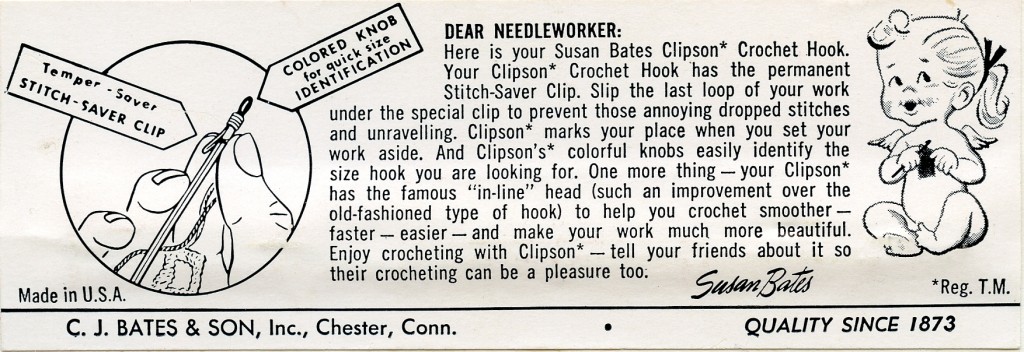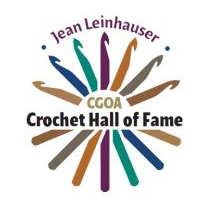Excerpts from C. J. Bates and Son, Inc. 1873-1973 100 Year History, internal document used with permission.
Back of package for Susan Bates Clipson® crochet hook explaining purpose of clip.
Bates is the oldest operating crochet hook manufacturer in the United States and by 1971 was the largest needlework tool manufacturer in the US. The company is named for Carlton Joseph Bates. Bates began working for the firm of Tyler and Post in 1861 at the age of 14 by stoking the stove and sweeping the floors before going off to school each day. Tyler and Post made small items from ivory discarded by a piano key manufacturer in a one-room shop. In 1865, Mr. Post bought out his partner and bought up another business, Griswolds, which made crochet hooks from whale bone (baleen) and cow shin bone.
Carlton Bates bought the business from Mr. Post in 1873. He continued to make small items such as crochet hooks, studs, stillettos, bodkins, and manicure implements from bone and ivory. Carlton’s son Hamilton took over the business when his father became seriously ill in 1893. Hamilton was chief executive until his retirement in 1954. Grandsons Hamilton Jr. and Wells assumed leadership of the company and incorporated it in 1960. Manicure implement production was sold in 1964 creating a needlework tools only company. In 1993, C. J. Bates and Son, Inc. became part of Coats and Clark.
Around 1905, whale bone (baleen) became scarce and its use discontinued. Cow shin bone was used exclusively for the manufacture of bone crochet hooks. By the end of the 1920s cattle were being slaughtered at an early age in the US. The shin bones were not long enough to make crochet hooks. Cattle in Argentina were allowed to grow larger so shin bone was imported from Argentina until the late 1960s when a special plastic replaced bone.
Originally, Bates needlework tools were unbranded or branded with private labels. Bates began using its own brand names, Chester and Barbara Bates, in the early 1930s. In the early 1940s Chester was changed to Zephr and Barbara Bates to Susan Bates.
Bates began expanding its needlework tool line in the early 1900s by introducing wooden crochet hooks. In the mid 1930s plastic crochet hooks and in the late 1930s aluminum crochet hooks were added to the line. During WWII, production of plastic hooks continued at a reduced rate while production of steel and aluminum items ceased entirely. Factories were converted to produce airplane fuel sight gauges and glider frames.
The company has received several patents and awards. In 1944 Bates received a patent for the in-line hook shape. In 1952 a patent was issued for the Clips-on thread retaining clip. The 1960s saw changes in mass marketing and Bates received several awards for packaging and display including awards for color coded crochet hooks and point of purchase displays.


[…] to an internal Bates document I found at the Lace Buttons blog, by 1971 Bates was the oldest and the largest operating crochet hook manufacturer in the United […]